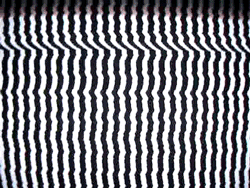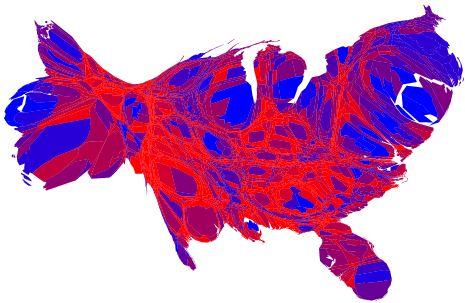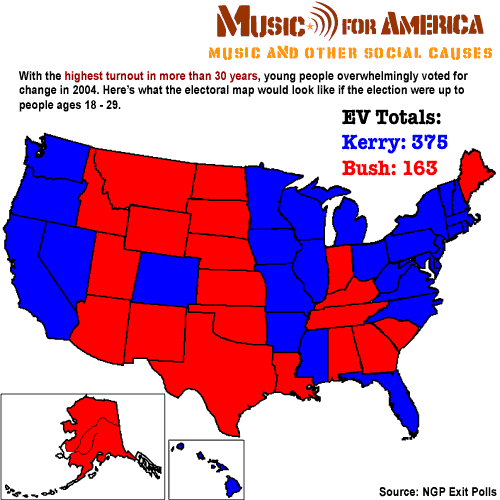View current page
...more recent posts

.GIF by jimpunk (from SCREENFULL: "we crash your browser with content").
"Eye Music." This post will eventually get around to techno music, but let's start with Claude Debussy. It's almost a cliche of criticism to compare the French composer's shimmery tone clusters to Impressionist painting. Daniel Albright's book of comparative aesthetics, Untwisting the Serpent: Modernism in Music, Literature and the Other Arts, takes a 180 degree tack, disagreeing with an assertion by Ezra Pound back in the day that Debussy's music is "suggestive of colors, suggestive of visions." According to Albright,
[...] Debussy's music is typically an art of slight temporal adjustments, discursive, an artful series of instabilities; it seems visual only because of the peculiar evolution of the visual arts in Europe, from the notion that the primary act of drawing is the recognizable depiction of a finite object--as it is in most cultures--to the notion that the primary act of drawing is the recognizable depiction of the eyeball's whole visual field. In Western art, the space in which objects appear is often more vivid than the objects themselves: perspective drawing carefully poses and graduates the objects that it treats, to create the illusion that the artist is presenting everything that a certain angle of vision makes available. Debussy's works are like French impressionist painting--or like Renaissance chiaroscuro, for that matter--in that the mind tries to grasp fleeting visual phenomena from a puzzling density of events. But it is not Debussy who is visual, but Monet and Leonardo who are discursive, in that they require the spectator to apprehend slowly and work out over time the possibilities inherent in the painted surface.The above paragraph is bang-on, but now it starts to get confusing:
Truly visual music, it seems to me, is epigrammatic: music that operates by means of instantaneously grasped units, pieced together not according to progressive tonalities, not according to some standard template of evolution (the sonata-allegro, the fugue, the rondo, the three-part song), but according to any principle that can not be understood as discursive development. Music becomes visual simply by lacking musically comprehensible connections between its parts, and by having parts that permit rapid apprehension as elementary units. Certain older procedures of form, such as the rondo (a repetitive piece with a pattern of symmetrical digressions, according to a scheme such a ABACABA), can approach the condition of eye music, in that the listener is conscious of the phonic equivalent of charms tallied on a bracelet; and as A and B get shorter and shorter, and as the musical links between A and B grow more unsettled and hard to understand, the composition will increasingly lose any sense of temporal progression and flatten into eye music. [...]These paragraphs sum up an earlier discussion of the "hieroglyph" or the "epigram" in music, a self-contained sonic event usually but not necessarily paired with words or some onstage deed. Albright describes these melodies or moments as having visual-like properties within the larger continuum of the piece. He gives several examples: the "oracle tune" in The Magic Flute, musical cues for specific emotions in silent film, and the motifs of the medieval master songs in Wagner's Die Meistersinger. Regarding the latter, he writes: "The rules [of the master songs] are discursive, but the discourse is chopped into tough leathery chunks, so predictable that the ear stops straining to understand, simply waits for the next bit to fall in place. A musical composition that consists of stringing-together of cadences has no possibility of moving toward a goal, no possibility of genuine discursive development at all." So in the rondo example above, the development of self-contained, multi-note motifs over time remains musical until the ear can no longer sort out their "narrative" structure, at which point they become visual--mere blocks of notes being absorbed and compared. Later, in describing the collage of musical motifs in Stravinsky's Renard, he concludes:
[T]he Modernist taste for ocularity in music, for easily-apprehended pattern-units juxtaposed rather than developed, brought the principle of scissors construction [collage] to its highest level. It is remarkable how strongly this procedure in sound appeals to the visual imagination: when I hear Stravinsky, I often feel exactly as Pound felt hearing Stravinsky's Capriccio in 1935--that a kind of slide projection of the score starts to hover in front of the music: "I had the mirage of seeing the unknown score from the aural stimulae offered."I still have questions, though. How can you envision a score without hearing a relationship between its parts? How is it that charms on a bracelet are "apprehended" musically but not as an image? Earlier in the book, Albright observes that Gotthold Lessing's analysis of the Laoco÷n problem---a consideration of ways emotions are expressed in different media, specifically sculpture and literature--has limited use to us now because it is so embedded in the conventions and decorum of the 18th Century. Perhaps Albright chafes against similar limitations, by restricting his discussion to classical music, which is so form- and history-ridden. One yearns to see his analysis applied to more contemporary, fluid, amorphous arts, such as jazz, rock/blues, or (finally getting to the point) Detroit techno, with its simple but elusive sequences of notes announcing themselves and dropping out in a dense, continuous mosaic. Without reference to words or stage pictures, one can easily "see" techno's unknown score; if anything, the genre is all about that--rhythm provides the sensual pleasure and structure the intellectual lift. As with many of Albright's examples, electronic dance loops lack the discursive complexity of a sonata or symphony; they switch on and off or change texture, conjuring a score like a Mondrian checkerboard, something Albright also invokes in his consideration of Stravinsky.

Another election map. This is not your country on drugs; it's what it really looks like. From Maps and cartograms of 2004 US presidential election results (hat tip to dave)
And this interesting factoid, from the DailyKos site: More people (56 million) voted against this president than any other in history. And this, also from Kos: Bush got the smallest percentage incumbent win since Woodrow Wilson in 1916.
My first compositional efforts using the SidStation synth, playing the notes in a notation program I downloaded called Harmony Assistant. I'm having fun, don't kid me too much.
"Funky Mountain Lake" [mp3 removed] The SidStation played "acappella," using the Lillhagen patch. I like the way the patch never seems to do the same thing twice--it always seems on the verge of breaking down or going seriously out of tune. And that it can add syncopation to a fairly clinical series of notes (see below) is amazing.
"Mountain Lake (Not Funky)" [mp3 removed] This is sort of a bonus track. It's the exact same sequence of notes used for "Funky Mountain Lake." The "lead" is the SidStation using the Autorepeat patch. I added another staff below it playing the same tune, using a kind of cheesy Harmony Assistant sound called Synthpad/Fantasia. This is unabashed Tangerine Dream/Phil Glass stuff, thrown in mainly to show how the Lillhagen patch utterly transforms the notes.
My complete musical works in .mp3 form are here.
We've been having a rousing discussion in the comments to the previous posts about the Karl Rove electorate manipulation--I mean, Bush victory. Too much of it has centered on whether the left is "too angry" and will turn off yahoos, when it's obvious that the Republicans won by channeling and redirecting mass rage. The issue to keep in mind is: Bush started a war against a nation that posed no threat to us. To fight it, he is using systematic torture and indiscriminate bombing. It is another Vietnam. 59 million people just endorsed that. The certainty that the left (and paleoconservative right) has that this is a failed enterprise has not spread to the general public. Events may soon prove Bush wrong more conclusively, but in the meantime it's important that we keep discussing, ridiculing, and even...horrors...hating the administration's foreign policy bungling. I believe the liberal left is innately better at getting out such memes because there's more creativity here, even though I wasn't that impressed with this year's political ads. Michael Moore, however, rules.
A few people asked how the Dorkbot talk went on Wednesday. I'd say well. For two hours everyone swallowed their politics (incredibly, since we were all still reeling after Kerry's concession) and had a nice talk about art. My bit ran about 30 minutes, and I enjoyed my first presentation using a laptop, projector and the Internet in lieu of the old slide projector. (Unfrozen Caveman Lecturer.) Seeing my portraits, animation, and abstraction blown up that big was exciting. I wasn't happy with my answers to a couple of questions toward the end, so I'll try again here. 1. Why the molecules? A: They're the most rudimentary, ordinarily seductive kind of thing to draw on the computer. Fill in a rectangle, fill in a circle, shade. Before I was making them on the computer I was painting them in the style of a computer. They are a dumb branded art thing like a Newman stripe or a Poons dot (or a Michael Rodriguez molecule--he also paints them), that, as Johns said about flags and targets, "frees me up to operate on other levels." Maybe it's arbitrary or obvious--I don't care, I like 'em. 2. Where are the grids of found animated gifs you sometimes post? Are they art or curation? A: Boiling my art activity down to a 25-minute speech was hard. The narrative I chose was, "how I make art objects with a crappy old program and how my production eventually began to expand to include animations of the same kind of imagery as I began blogging." I had to leave a lot out, including my burgeoning music career (!), and the weird overlap of blogging, curating, and artmaking that has been a fairly constant theme on this page.
Also of note was the guy who kept asking Claire Corey pointed questions about why she makes digital paintings for gallery consumption. Why abstract expressionism, this art of the 50s? What do you get from printing it out that you don't get onscreen? Are you selling a painting or a file? The latter two questions came after Corey had explained the pains she went to to make a unique, color adjusted print on canvas, stretching it like a conventional painting so that it had scale and sensuousness and optical complexity in real space. I'm guessing the questioner was coming from some sort of conceptualist, information wants to be free frame of reference in that he seemed genuinely startled, perhaps a bit put out, that Claire was showing and selling her work in galleries. From what I've observed over the years, she gets it coming and going: the gallery world wants there to be actual paint somewhere on that canvas to legitimize it. For some reason, a digital painting pushes lots more buttons than a digitally made and printed photo. Very fertile area to be working, IMHO.
Many thanks to Douglas Repetto for inviting us to speak and making things run so smoothly. He's an awesome moderator, and it's great to see the Dorkbot empire gradually spread around the world.
Another map, this one via thickeye:

In the comments, Cinque H continues to call for temperate language towards the Bushvoters. He's living out there among them, so maybe it's like, don't say Big Smelly Cat when you're in a cage full of lions. I understand all that about being noble and not sinking to the level of right wing hate rhetoric, but I disagree with the analogy of the Bushvoters defending themselves being like us having to defend Clinton after Waco (and other bad things that happened from '92-'99). Barbecuing 80 Americans for their religious practices was awful, but Iraq is infinitely worse--it's simply not defensible on any level except "me dumb me see Saddam on teevee he bad man." Assuming the 59 million people aren't out and out mentally handicapped, they are morally culpable for the killing in Bush's vendetta. I'm not interested in winning them over, I'd rather see them disappear through attrition and old age (see previous post re: demographics) and keep working on the ones who didn't vote, making intellectual freedom seem fun and sexy. Also, you can't reason with the wingnuts, we have one that keeps popping up on this site repeating the same tired phrases no matter how sensitive and rational people try to be.
Well, this is encouraging. This is what the electoral map would look like if only young people voted:

As the Daily Kos poster who found this says:
The reality is that Bush won by increasing his support in every age group above 30, adding SEVEN POINTS in the 60+ bracket alone over 2000.
Luckily for America, old people die. If we can maintain our edge with young voters and hold on to those we've got as they get older, the right wing revolution will come to an end four years from now.
The only question is whether or not we can hold the line and keep a country worth fighting for until then.
